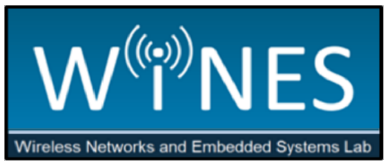Education
- Ph.D. in Computer Engineering (expected 2027) - Northeastern University, Boston, MA, USA
- M.Sc. in Mechatronic Engineering (2022) - Polytechnic University of Turin, Turin, Italy
- B.Sc. in Mechanical Engineering (2020) - Polytechnic University of Turin, Turin, Italy
Research Interests
- 5G and beyond cellular networks
- OpenRAN and O-RAN
- Network Optimization
- Intrabody Communication
- Earth-to-Satellite Communication
- Cellular Network Support for UAVs
Pietro is a PhD Candidate at the Institute for the Wireless Internet of Things at Northeastern University under Prof. Tommaso Melodia, where he stayed after a visiting period for his Master Thesis in 2022. He graduated at Politecnico di Torino in Mechatronic Engineering in 2022, and in Mechanical Engineering in 2020. He visited the University of Porto in 2019 and the Technion Israel Institute of Technology in Haifa in 2021 as an exchange student. He also graduated from Alta Scuola Politecnica, a joint honor program of Politecnico di Torino and Politecnico di Milano for the top 1% students of both universities. His interests include Open RAN, 5G & 6G, Intra-body Communication, Space Communication, and UAVs.
Publications
2025
Journals and Magazines
The O-RAN ALLIANCE is defining architectures, interfaces, operations, and security requirements for cellular networks based on Open Radio Access Network (RAN) principles. In this context, O-RAN introduced the RAN Intelligent Controllers (RICs) to enable dynamic control of cellular networks via data-driven applications referred to as rApps and xApps. RICs enable for the first time truly intelligent and self-organizing cellular networks. However, enabling the execution of many Artificial Intelligence (AI) algorithms making autonomous control decisions to fulfill diverse (and possibly conflicting) goals poses unprecedented challenges. For instance, the execution of one xApp aiming at maximizing throughput and one aiming at minimizing energy consumption would inevitably result in diametrically opposed resource allocation strategies. Therefore, conflict management becomes a crucial component of any functional intelligent O-RAN system. This article studies the problem of conflict mitigation in O-RAN and proposes PACIFISTA, a framework to detect, characterize, and mitigate conflicts generated by O-RAN applications that control RAN parameters. PACIFISTA leverages a profiling pipeline to tests O-RAN applications in a sandbox environment, and combines hierarchical graphs with statistical models to detect the existence of conflicts and evaluate their severity. Experiments on Colosseum and OpenRAN Gym demonstrate PACIFISTA's ability to predict conflicts and provide valuable information before potentially conflicting xApps are deployed in production systems. We use PACIFISTA to demonstrate that users can experience a 16% throughput loss even in the case of xApps with similar goals, and that applications with conflicting goals might cause severe instability and result in up to 30% performance degradation. We also show that PACIFISTA can help operators to identify conflicting applications and maintain performance degradation below a tolerable threshold.
LinkDeploying and testing cellular networks is a complex task due to the multitude of components involved from the core to the radio access network (RAN) and user equipment (UE), all of which requires integration and constant monitoring. Additional challenges are posed by the nature of the wireless channel, whose inherent randomness hinders the repeatability and consistency of the testing process. Consequently, existing solutions for both private and public cellular systems still rely heavily on human intervention for operations such as network reconfiguration, performance monitoring, and end-to-end testing. This reliance significantly slows the pace of innovation in cellular systems. To address these challenges, we introduce 5G-CT, an automation framework based on OpenShift and the GitOps workflow, capable of deploying a soft-warized end-to-end 5G and O-RAN-compliant system in a matter of seconds without the need for any human intervention. We have deployed 5G-CT to test the integration and performance of open-source cellular stacks, including OpenAirInterface, and have collected months of automated over-the-air testing results involving software-defined radios. 5G-CT brings cloud-native continuous integration and delivery to the RAN, effectively addressing the complexities associated with managing spectrum, radios, heterogeneous devices, and distributed components. Moreover, it endows cellular networks with much needed automation and continuous testing capabilities, providing a platform to evaluate the robustness and resiliency of Open RAN software.
LinkConference Papers
We analyze the open-loop mechanical tracking performance of a sub-Terahertz (sub-THz) and Terahertz (THz) uplink communication system. These high-frequency bands enable multi-gigabit links through large bandwidths and narrow beams, but require precise pointing to overcome spreading loss. A tracking system can be used to orient horn antennas toward mobile targets. We develop a mathematical model that captures the mechanical dynamics of a real tracking system, which includes motion latency and acceleration and velocity limits, to quantify pointing errors during satellite passes and integrate these effects into the link budget. We evaluate the trade-offs between beam directionality and pointing tolerance across different Low Earth Orbit (LEO) satellite trajectories and control strategies. The results link the hardware limitations to the communications performance, providing design guidelines for high-frequency Non-Terrestrial Network (NTN) uplink under practical mechanical constraints.
Link2024
Journals and Magazines
This demo presents SeizNet, an innovative system for predicting epileptic seizures benefiting from a multi-modal sensor network and utilizing Deep Learning (DL) techniques. Epilepsy affects approximately 65 million people worldwide, many of whom experience drug-resistant seizures. SeizNet aims at providing highly accurate alerts, allowing individuals to take preventive measures without being disturbed by false alarms. SeizNet uses a combination of data collected through either invasive (intracranial electroencephalogram (iEEG)) or non-invasive (electroencephalogram (EEG) and electrocardiogram (ECG)) sensors, and processed by advanced DL algorithms that are optimized for real-time inference at the edge, ensuring privacy and minimizing data transmission. SeizNet achieves > 97% accuracy in seizure prediction while keeping the size and energy restrictions of an implantable device.
LinkConference Papers
Wireless Sensor Networks (WSNs) are pivotal in various applications, including precision agriculture, ecological surveillance, and the Internet of Things (IoT). However, energy limitations of battery-powered nodes are a critical challenge, necessitating optimization of energy efficiency for maximal network lifetime. Existing strategies like duty cycling and Wake-up Radio (WuR) technology have been employed to mitigate energy consumption and latency, but they present challenges in scenarios with sparse deployments and short communication ranges. This paper introduces and evaluates the performance of Unmanned Aerial Vehicle (UAV)-assisted mobile data collection for WuR-enabled WSNs through physical and simulated experiments. We propose two one-hop UAV-based data collection strategies: a naïve strategy, which follows a predetermined fixed path, and an adaptive strategy, which optimizes the collection route based on recorded metadata. Our evaluation includes multiple experiment categories, measuring collection reliability, collection cycle duration, successful data collection time (latency), and node awake time to infer network lifetime. Results indicate that the adaptive strategy outperforms the naïve strategy across all metrics. Furthermore, WuR-based scenarios demonstrate lower latency and considerably lower node awake time compared to duty cycle-based scenarios, leading to several orders of magnitude longer network lifetime. Remarkably, our results suggest that the use of WuR technology alone achieves unprecedented network lifetimes, regardless of whether data collection paths are optimized. This underscores the significance of WuR as the technology of choice for all energy critical WSN applications.
Link2023
Journals and Magazines
In this study, a non-invasive system is proposed for monitoring the health of vine plants by measuring their water stress, with the goal of mitigating frequent extreme meteorological events such as droughts. The envisioned system measures the spatial distribution of the Crop Water Stress Index (CWSI) on the crop field and provides the farmers with precise control over their vine's health and, therefore, on the final quality of their product. To ensure the accurate acquisition of the parameters needed to compute the CWSI, data are collected by field sensors on the ground and by exploiting satellite data. Data fusion then allows us to obtain an associated georeferenced heatmap of the vineyard. The solution has been tested via a prototype, which allowed the collection of information in a vineyard.
Link
